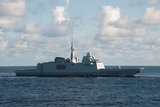Ultra Electronics DNE Technologies announces SFL for CV-MCU2+
Ultra Electronics DNE Technologies, a leading provider of protocol converter equipment for the defense industry, announces the launch of its Satellite Fiber Link (SFL) module set for the CV-MCU2+ platform.
DNE Technologies SFL modules deliver a high performance alternative to coaxial cable for transmitting L-band signals between a satellite terminal and antenna. SFL modules enable longer RF transmission distances while retaining the highest level of signal quality. This allows users to move satellite terminals and associated equipment into protected areas while remoting the antenna in the best location for transmission. In addition to improved drive distances, users can benefit from electrical isolation, immunity to interference (EMI/RFI/lightning), and improved security of information that fiber optic signalling provides. The SFL modules offer the widest dynamic range of operation, seamlessly passing L-band signals without restricting the performance of the satellite modems. The programmable RF input range allows the user to configure for any satellite terminal equipment without calibration.
"DNE is pleased to announce the addition of L-band fiber extension to the CV-MCU2+ portfolio. These modules fill an important void in tactical satellite communications ground equipment used in theater today," commented Diane Lagel, Product Manager of Multiplexers and Modems at DNE Technologies. Charles Reese, Vice President of Sales & Marketing at DNE Technologies, added, "Satellite terminal integrators will enjoy significant size and weight savings by combining Ethernet, TRI-TAC, and now L-band IFL fiber interfaces in a 1RU chassis."
The CV-MCU2+ SFL modules will be generally available in March 2011. Fully configured systems range from $11,000 to $14,000 USD.
Source: Ultra Electronics
More from Digital Battlespace
-
![Babcock nears first customer for Nomad AI translation tool]()
Babcock nears first customer for Nomad AI translation tool
Nomad can provide militaries with real-time intelligence, saving critical time on the battlefield.
-
![AUSA 2025: Israel’s Asio Technologies to supply hundreds of improved Taurus tactical systems]()
AUSA 2025: Israel’s Asio Technologies to supply hundreds of improved Taurus tactical systems
Taurus operates alongside the Israel Defense Forces’ Orion system which supports mission management across tens of thousands of manoeuvring forces, from squad leaders to battalion commanders.
-
![AUSA 2025: Kopin pushes micro-LED plans as China moves faster]()
AUSA 2025: Kopin pushes micro-LED plans as China moves faster
The plan for the new displays follows fresh investment in Kopin’s European facilities by Theon and an order for head-up displays in fielded aircraft, with funding from the US Department of Defense.
-
![AUSA 2025: Persistent Systems to complete its largest order by year’s end]()
AUSA 2025: Persistent Systems to complete its largest order by year’s end
Persistent Systems received its largest ever single order for its MPU5 devices and other systems earlier this month and has already delivered the 50 units to the US Army’s 4th Infantry Division.
-
![Aselsan brings in dozens of companies and systems under the Steel Dome umbrella]()
Aselsan brings in dozens of companies and systems under the Steel Dome umbrella
Turkey has joined the family of countries attempting to establish a multilayered air defence system with government approval in August 2024 for the effort landed by Aselsan. Dubbed Steel Dome, the programme joins Israel’s Iron Dome, the US Golden Dome, India’s Mission Sudarshan Chakra and South Korea’s low-altitude missile defence system.
-
![DSEI 2025: MARSS unveils new agnostic multidomain C4 system]()
DSEI 2025: MARSS unveils new agnostic multidomain C4 system
MARSS’ NiDAR system has been deployed using sensors from static platforms to provide detection and protection for static sights, such as critical infrastructure, ports and military bases.




























